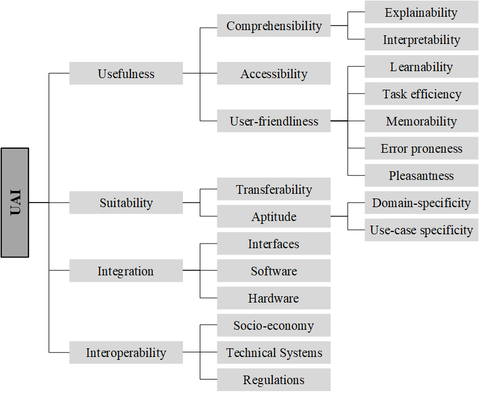Approach to usable artificial intelligence (UAI) for domain-specific applications, particularly in engineering
Motivation
Data-driven methods, machine learning and artificial intelligence methods, are not yet exploited to their intended potential in solving the technical-technological challenges, especially in industrial applications, despite versatile development progress. This is mainly justified by the insufficient practicality of AI solutions. To exploit the potential of AI methods, technical practitioners often rely on interdisciplinary collaboration with data science specialists or consultants. In any development and application of AI methods, a plethora of methods must be mastered for solution-oriented acquisition, pre-processing and quality assurance of required data, as well as for the selection of suitable algorithms and their adaptation. Coping with this complexity usually requires a great deal of effort, both for the individual domain expert and for the data en-gineers and data analysts. Complexity and intransparency of AI methods there-fore hinder the effectiveness and efficiency of AI deployment. Focusing on us-er-friendly delivery of AI-based applications, the paradigm of Usable AI (UAI) has been defined.
Approach to user-focused, usable AI (UAI)
The UAI paradigm places an interactive communicative layer between the us-er-centric bottom-up view and the modeling-based top-down view. The concept aims for this communicative layer to proactively be approached by both sides. The UAI layer is supposed to provide structure, comprehensible methodological knowledge and guidance fitted to the respective users. To address the relevant user roles, the provided methods need to relate to each of the user roles, providing the means to grasp complex concepts to the necessary extent for application. Most im-portantly, the communicative UAI layer not only supports the provision of AI solution concepts to potential users, but also forms a common basis for rendering do-main-specific requirements visible. By providing domain context for method develop-ers, supporting goal communication within the domain context and presenting data science insights to users in a comprehensible manner, UAI establishes a major leap towards applicability of AI methods.

Layer of AI
Figure 1: Layers of AI model comprehensiveness
The elements of the UAI paradigm are shown in Fig. 2 and serve as a blueprint for considering all user needs. The sub-attributes must be considered to achieve usability of an AI application. Consequently, it is critical to consider all attributes when determining user requirements for a given use case and to tailor solution approaches to the user role, goal, and domain context in each of these categories.

Features of UAI
Figure 2: Anatomy of the Usable Artificial Intelligence (UAI) Paradigm
Details have been published in [1, 2, 3].
Current research projects
This paradigm underlies all projects aimed at AI applications. Our motivation are applications that can be used efficiently and user-friendly on the shop floor.
For companies we offer consulting as well as qualification formats.
Call to Action
We are interested in a cross-domain discussion of our proposal for the UAI paradigm. In addition, we would like to participate in research projects that aim to make AI user-friendly. Joint evaluations and publications would be very important to us.
References
| 3 | Wiemer, H.; Conrad, F.; Lang, V.; Boos, E.; Mälzer, M.; Feldhoff, K.; Drowatzky, L.; Schneider, D.; Ihlenfeldt, S.: Illustration of the Usable AI Paradigm in Production-Engineering Implementation Settings. In: Degen, H., Ntoa, S. (eds) Artificial Intelligence in HCI. HCII 2023. Lecture Notes in Computer Science (pp.640-661), vol 14050. Springer, Cham. https://doi.org/10.1007/978-3-031-35891-3_40 |
| 2 |
Wiemer, H. ; Conrad, F.; Lang, V.; Boos, E.; Mälzer, M.; Feldhoff, K.; Drowatzky, L. ; Schneider, D.; Ihlenfeldt, S.: Illustration of the Usable AI Paradigm in Production-Engineering Implementation Settings. HCI international 2023, 25th International Conference on Human-Computer Interaction, Copenhagen, Denmark 23-28 July 2023, Proceeding accepted and plannend In: Lecture Notes in Computer Science series. Springer Volume 14050 |
| 1 | Wiemer, H.; Schneider, Dorothea; Lang, Valentin; Conrad, Felix; Mälzer, Mauritz; Boos, Eugen; Feldhoff, Kim; Drowatzky, Lucas; Ihlenfeldt, Steffen: Need for UAI–Anatomy of the Paradigm of Usable Artificial Intelligence for Domain-Specific AI Applicability. Multimodal Technol. Interact. 2023, 7(3), 27; https://doi.org/10.3390/mti7030027 |
